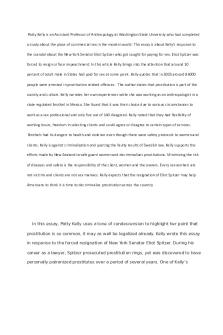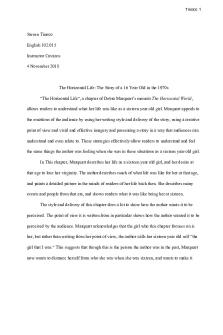Assessment Two Rhetorical Analysis - COMM PDF

| Title | Assessment Two Rhetorical Analysis - COMM |
|---|---|
| Course | Academic Communication: Conventions and Expectations |
| Institution | Auckland University of Technology |
| Pages | 5 |
| File Size | 94.7 KB |
| File Type | |
| Total Downloads | 37 |
| Total Views | 140 |
Summary
rhetorical analysis on tedtalk rape culture...
Description
Abigail Kaushal
20113013
COMM570/22
Rhetorical Analysis
The public text I am analysing for my rhetorical analysis is ‘Rape Culture’, a TED Talk presented by Reagan Williams in Arkansas State University on April the 4 th 2017. Williams begins this presentation with why rape culture is an issue. She talks about how victims experience secondary victimisation when coming forward due to the stigma of rape culture, such as victim blaming attitudes: “they were asking for it”. As a result of rape culture and secondary victimisation, 68% of rapes will never be reported. Williams goes on to talk about how rape culture influences prison sentences and punishment for rapists, that only 6% of reported rapes in the USA will end in a prison sentence with 99% of rapists getting away with their crimes. She then discusses how society has a preconceived idea of what rape is and what a rapist looks like and that it isn’t occurred by a stranger from “a bad part of town”, instead, 8/10 sexual assaults occur between someone who is known to the victim. Williams then goes on to talk about how rapists are constructed by sociocultural attitudes that shape and modify their violence and that although talking about sexual assault is uncomfortable, we need to do it.
The purpose of this public text is to increase awareness of rape culture within society. Williams goes on to describe individuals’ personal experiences, whilst providing national statistics on sexual violence and rape, this in turn accomplishes her purpose of raising awareness of the consequences of rape culture within society. This presentation was intended to inform all viewers on what rape culture is and its effects whilst persuading the audience to evaluate how they subconsciously contribute too. This argument addresses any person, with no bias to their race or gender. Williams states how society as a whole has created rape culture and it is not one person’s creation,
Abigail Kaushal
20113013
COMM570/22
and is challenging every person who watches her presentation to see how they have personally contributed to rape culture. Prior to individuals watching this TED Talk, they may be aware of the stigma of victim blaming and this perception of what a rapist is due to portrayals in the media. However, those watching the text are likely to change their views of this portrayal of a rapist and gain knowledge on the true nature of rape and rape culture. This TED Talk is addressing the high rates of sexual assault and how rape culture contributes to these high rates. Rape culture has always been an issue which is what motivated this to become a TED Talk.
There is a lot of information to absorb and state when it comes to rape culture as it is such a personal and triggering topic to discuss, as Williams mentions that “sexual assault is uncomfortable to discuss, but it needs to be done.” This creates limitations regarding the subject of this text as TED Talks range in length, with this being almost 18 minutes long, which could potentially restrict the amount of information added into this talk. Individuals who attend TED Talk’s do so willingly, which means they should expect to be sitting down for a long period of time whilst listening to each presenter. Consequently, this could lead to the audience not paying attention, feeling bored and distracted. This can relate to other TED Talks as the audiences may not be interested in the topics being discussed and are there to hear another presentation. This public text is organised as Williams arranged it so that every sentence, she says is impactful and powerful in order to gain the audience's attention. She includes stories from those who have been assaulted, and her own personal experience, to portray and explain the significance of rape culture and what it does to an individual who is victimised. Williams put time and effort into the structure of her TED Talk.
Abigail Kaushal
20113013
COMM570/22
The rhetorical appeals that this text makes use of is Pathos and Logos. Williams gains the attention of the audience by using emotions throughout her presentation by describing how victim blaming attitudes create a “second victimisation” and the very topic that is being discussed is an extremely emotional and personal topic. Whilst talking about triggering and emotional stories, Williams also backs them up with facts. Williams brings up statistics such as how only 6% of reported rapes in the U.S end in a prison sentence leading to 99% of rapists getting away with their crimes. The fact that Williams is using Pathos and Logos as her rhetorical appeals throughout this public text, can likely influence her audience as not only is she talking about raw and personal emotions, she is backing these feelings up with recorded statistics. Williams establishes her own credibility by not being bias towards men, as they are the prime perpetrators for sexual violence against women. Instead, she talks about how men are victims and at risk of rape culture too. Whilst telling the stories of victim’s sexual assaults, Williams used graphic detail and emotions. The effectiveness of this is to gain the audience's attention and empathy. Williams is knowledgeable on the subject of rape culture as she describes how she was sexually assaulted by her ex-boyfriend as a young girl. Furthermore, establishing her credibility as the topic she is discussing, she has first-hand experience with. Williams establishes the credibility of the information presented in the public text by referencing resources such as the ‘National Sexual Violence Resource Center.’ The evidence that Williams used to support the claims of her text are highly appropriate, such as 8/10 sexual assaults occur from someone known to the victim as she is telling the truth of sexual assaults and the statistics, instead of the preconceived idea of what sexual assault is. Williams couldn’t solely use the victim's stories, so providing statistics along with these stories, provides credibility to Williams' presentation. Throughout the text, the rhetorical elements of ethos, pathos and logos interacted with each other.
Abigail Kaushal
20113013
COMM570/22
Williams started off by crediting herself, telling the audience what she is studying and what her plans are for her future whilst also talking about her personal experience with rape culture which is the elements of ethos. She then goes on to discuss victims stories and tells their stories in detail, evoking raw emotions. Williams also talks about how rape culture leads victims to feel a second victimisation and how this can cause victims to self-harm and promiscuity which is the elements of pathos. Whilst Williams discusses elements of pathos, it coincides with the elements of logos. As she discusses victims’ stories and the consequences of rape culture, Williams also provides statistics on sexual violence. Without the elements of logos to back up her statements of pathos, it would have sounded to the audience like she was stating an opinion as a fact.
Considering the topic of the text and audience, the language used to form this public text was appropriate. Williams used formal language to discuss the topic of rape culture which was sensible as it is such a sensitive and personal subject it would have been disrespectful to do so otherwise. Throughout the text, keywords such as ‘victims’ and ‘victimisation’ were repeated often for rhetorical effect. Using these keywords potentially gained the attention of the audience as it would be talking about something personal and using the rhetorical element of pathos.
The public text, ‘Rape Culture’, was extremely effective in conveying its message to me. I was highly engaged throughout the presentation, absorbing all of the information Williams provided. Before going into watching this TED Talk, I had a fair idea of what rape culture was and the statistics, however I have come out with more information than I thought I knew. The way that Williams used the rhetorical elements of logos and pathos impacted me and made me feel engaged as we are all victims of rape culture,
Abigail Kaushal
20113013
COMM570/22
whether we choose to believe it or not. I was already a strong believer in taking down the toxicity of rape culture but the statistics and stories which Williams shared has made me feel even stronger in eliminating rape culture. Starting with believing every victim story there is, as Williams stated only 2-8% of all reported rapes are false accusations. Williams did a wonderful job presenting this TED Talk and provided strong rhetorical effectiveness of the arguments itself.
Word Count: 1,387...
Similar Free PDFs

Assessment Two - Tesco\'s Analysis
- 19 Pages

Rhetorical Analysis
- 5 Pages

Rhetorical analysis
- 2 Pages

Puppy Rhetorical Analysis
- 4 Pages

Rhetorical analysis -1
- 4 Pages

Bowling Dana Rhetorical Analysis
- 4 Pages

Rhetorical Analysis Essay
- 5 Pages

Textual Rhetorical Analysis
- 3 Pages

Rhetorical Analysis Final
- 5 Pages

Rhetorical Analysis Prompt
- 2 Pages

Final Rhetorical Analysis Essay
- 2 Pages

Rhetorical analysis pt1
- 2 Pages
Popular Institutions
- Tinajero National High School - Annex
- Politeknik Caltex Riau
- Yokohama City University
- SGT University
- University of Al-Qadisiyah
- Divine Word College of Vigan
- Techniek College Rotterdam
- Universidade de Santiago
- Universiti Teknologi MARA Cawangan Johor Kampus Pasir Gudang
- Poltekkes Kemenkes Yogyakarta
- Baguio City National High School
- Colegio san marcos
- preparatoria uno
- Centro de Bachillerato Tecnológico Industrial y de Servicios No. 107
- Dalian Maritime University
- Quang Trung Secondary School
- Colegio Tecnológico en Informática
- Corporación Regional de Educación Superior
- Grupo CEDVA
- Dar Al Uloom University
- Centro de Estudios Preuniversitarios de la Universidad Nacional de Ingeniería
- 上智大学
- Aakash International School, Nuna Majara
- San Felipe Neri Catholic School
- Kang Chiao International School - New Taipei City
- Misamis Occidental National High School
- Institución Educativa Escuela Normal Juan Ladrilleros
- Kolehiyo ng Pantukan
- Batanes State College
- Instituto Continental
- Sekolah Menengah Kejuruan Kesehatan Kaltara (Tarakan)
- Colegio de La Inmaculada Concepcion - Cebu



